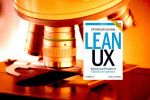Lean UX

Lean UX: Applying Lean Principles to Improve User Experience by Jeff Gothelf with Josh Seiden
Traditional software development and interface design practices typically involve “big, up front design” deliverables that are created by an independent design team and handed off to software engineers. Lean UX
is a move towards reducing the waste that is frequently found in the user experience design process by incorporating agile software development principles. By reducing the number of deliverables and handoffs, identifying specific measurable outcomes, and decreasing the distance between the customer and the team, Lean UX makes the design process more inclusive, better informed, and more accurately directed at business outcomes. Rather than focusing on a perfect design to be used as a specification for developers, Lean UX relies on collaboration, experimentation, and metrics to achieve success.
A fundamental shift in the design approach championed by Lean UX is the idea that everyone should be part of the design process, not just the designers. This is how continuous customer discovery is achieved and how customer data and insights are brought into the larger development and design process.
Lean UX is the practices of bringing the true nature of a product to light faster, in a collaborative, cross-functional way that reduces the emphasis on thorough documentation while increasing the focus on building a shared understanding of the actual product experience being designed.
Lean UX Foundations and Principles
Lean UX is built on three foundational concepts: design thinking, agile software development, and Eric Ries’ Lean Startup method. Design thinking expands the discipline of design to all aspects of business and encourages all team members to participate in the design process. Agile software development overturns many traditional software development approaches and emphasizes collaboration, working software, and responding to change. The Lean Startup method spawned the “minimum viable product” concept and uses the “build-measure-learn” cycle to test quickly hypotheses about the product and market.
Gothelf and Seiden list a dozen principles which underly the Lean UX approach. Key among them are:
- Highly collaborative, co-located, cross functional teams
- Outcomes, not outputs, are indicators of progress
- Teams focus on market problems, not features
- Continuous discovery of customer insights (what are your customers doing with your products and why)
- Getting out of the building (per Steve Blank, the only true product and customer knowledge exists outside your building)
- Nail it then scale it; emphasize learning over growth
- Making over analysis, experimentation to learn and externalizing your work
Elements of the Lean UX Process
Our goal is not to create a deliverable, it’s to change something in the world–to create an outcome. We start with assumptions instead of requirements. We create and test hypotheses. We measure to see whether we’ve achieved our desired outcomes.
Hypotheses and problem statements
The hypothesis statement enables the team to shift from outputs (features) to outcomes (measurable aspects of customer lives and business environments). It consists of assumptions, the hypothesis itself, outcomes, personas, and features. Declaring assumptions is an important foundational step in product development because it exposes the starting point for the team’s knowledge and intended direction. The book offers a great template for supporting the assumption exercise:
[Our service/product] was designed to achieve [these goals]. We have observed that the product/service isn’t meeting [these goals], which is causing [this adverse effect] to our business. How might we improve [service/product] so that our customers are more successful based on [these measurable criteria]?
Another tool for surfacing assumptions is Giff Constable‘s Business Assumptions Worksheet.
The complement to the problem statement is the hypothesis statement:
We believe [this statement is true]. We will know we’re [right/wrong] when we see the following feedback from the market: [qualitative feedback] and/or [quantitative feedback] and/or [key performance indicator change].
Making assumptions, metrics, and connections explicit helps the team learn and adjust. Many product development efforts proceed blindly with unstated assumptions toward vague outcomes.
The Lean UX process
The Lean UX cycle involve declaring assumptions, creating a minimum viable product (MVP), running an experiment, and getting feedback and research. Once assumptions, problem statements, and hypotheses have been stated an MVP is created to test the hypothesis. The purpose of the MVP is to test a specific hypothesis and use the learnings to guide the next experiment. For an effective MVP, identify what you are trying to learn, what market signals or proxies will validate you hypothesis, and the fastest way to get the information.
Collaborative design and discovery support the entire Lean UX method. The whole team should be involved in design. The book gives details about the Design Studio approach in which every team member submits designs, rates designs, and contributes to evolving the final design. Collaborative discovery enables all team members to interact with and learn from the customers and/or users of the product. Gothelf and Seiden warn against outsourcing this activity outside the team–it removes the team from contact with the people who are using the product.
There are many additional sources of customer data that can be used to achieve continuous discovery: customer service data, on-site feedback surveys, sales data, professional services teams, and any team which regularly interacts with customers.
Designers can demonstrate their problem solving skills by illustrating the path they took to get from idea to validated learning experience. In doing so, they’ll demonstrate their deep worth as designer.
Experimentation
Technology has changed to a point where we can deliver ideas…not necessarily even baked ideas or feature ideas…to our target audience very, very quickly, and that allows us to learn whether or not it is worth for us to explore these ideas any further
Gothelf talks in this video about one of the primary Lean UX themes: experimentation and decreasing risk through small releases which are judged objectively. He describes it as an “evidence based decision making process to learn what features are worth investing in.” Rapid and iterative testing against objective criteria which have business impact (e.g., viewing, sharing, recommending content). The video features a mini-case study from the BBC music service. Gothelf notes that because continuous learning and objective decision making threatens traditional command-and-control corporate structures, many cultural shifts (listed in the book) must be made in the organization to support Lean UX success.
You need to be comfortable killing off your ideas early
Lean UX: Applying Lean Principles to Improve User Experience







